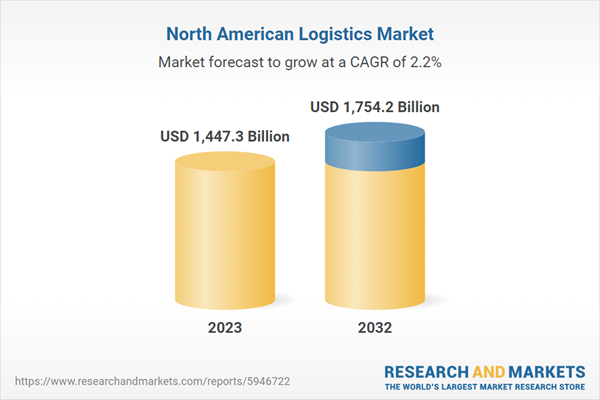Logistics refers to the process of planning, coordinating, and executing the efficient flow and storage of goods, services, and information from the point of origin to the point of consumption. It involves the management of various activities such as transportation, inventory management, warehousing, packaging, and distribution. Logistics ensure that the right product is delivered to the right place, at the right time, and in the right condition, all while optimizing costs and minimizing disruptions. It is essential in supply chain management, as it involves the coordination of multiple stakeholders, including suppliers, manufacturers, distributors, retailers, and customers. Additionally, effective logistics involves strategic decision-making, utilizing technology and data analytics to optimize routes, manage inventory levels, track shipments, and streamline processes.
The market is primarily driven by increasing international trade, requiring efficient transportation and distribution networks to move goods across borders. In addition, the significant expansion in the e-commerce industry, as online shopping continues to gain popularity which requires a robust logistics infrastructure to handle the growing volume of shipments influencing the market growth. Moreover, several advancements in the logistics industry technology, such as the adoption of automation, artificial intelligence (AI), and data analytics optimize supply chain operations, reduce costs, and improve efficiency represents another major growth-inducing factor. Besides this, the shift toward just-in-time manufacturing and inventory management is escalating the demand for reliable logistics services to ensure the timely delivery of components and products propelling the market growth. Furthermore, changing consumer expectations, including faster delivery times and transparent tracking systems, have accelerated companies to invest in advanced logistics capabilities which is creating a positive market outlook.
North America Logistics Market Trends/Drivers:
The expanding e-commerce industry
The demand for logistics services is experiencing substantial growth due to the expanding e-commerce sector and growing international trade. In addition, the increasing cross-border trade is escalating the demand for logistics services. As businesses strive to reach international customers, they require efficient logistics networks to transport goods seamlessly and securely across borders resulting in a growing demand for freight forwarding, customs clearance, and international shipping services. Moreover, the e-commerce sector is expanding, with more consumers opting for online shopping representing another major growth-inducing factor. Also, e-commerce companies rely heavily on logistics to fulfill orders and deliver products to customer's doorsteps propelling the market growth. Furthermore, the rapid growth of online retail has fueled the need for robust last-mile delivery solutions, warehousing facilities, and order fulfillment capabilities.Numerous technological advancements in the logistics industry
The widespread adoption of numerous advanced technological solutions is making operations more efficient, cost-effective, and streamlined. In addition, the extensive use of advanced analytics and big data is escalating the demand for logistics services. Logistics companies are using data to gain valuable insights into supply chain processes, optimize routes, forecast demand, and improve operational efficiency which is influencing the market growth. Also, real-time tracking and monitoring systems enable better visibility and transparency throughout the supply chain, ensuring timely delivery and reducing the risk of disruptions. Besides this, the Internet of Things (IoT) has enabled the integration of sensors and connected devices in logistics operations, providing real-time data on shipment conditions, such as temperature, humidity, and location, ensuring the integrity and security of goods during transit accelerating the market growth. Along with this, the widespread adoption of cloud computing has facilitated data storage, collaboration, and scalability, enabling logistics companies to handle vast amounts of data and scale their operations propelling the market growth. Furthermore, emerging technologies such as artificial intelligence (AI), machine learning (ML), and blockchain are also helping in demand forecasting, route optimization, and predictive maintenance. Blockchain technology ensures secure and transparent transactions, enhances supply chain visibility, and improves traceability, creating a positive market outlook.North America Logistics Industry Segmentation:
The publisher provides an analysis of the key trends in each segment of the North America logistics market report, along with forecasts at the regional and country levels from 2024-2032. The report has categorized the market based on model type, transportation mode and end-use.Breakup by Model Type:
- 2 PL
- 3 PL
- 4 PL
2 PL dominate the market
The report has provided a detailed breakup and analysis of the market based on the model type. This includes 2 PL, 3 PL, and 4 PL. According to the report, 2 PL represented the largest segment.Second-party logistics refers to a model in which a company outsources its logistics operations to a single service provider, often a transportation or logistics specialist. In addition, many companies prefer to focus on their core competencies and outsource non-core activities such as logistics to specialized service providers influencing market growth. Along with this, companies rely on 2 PL providers to use their expertise and infrastructure, resulting in cost savings and improved efficiency, propelling market growth.
Moreover, 2 PL providers have the necessary resources, industry knowledge, and established networks to handle logistics requirements effectively in North America representing another major growth-inducing factor. Furthermore, 2 PL providers offer customized solutions customized to the specific needs of their clients, this flexibility and adaptability are particularly attractive to companies operating in the North American logistics market, where diverse industries and supply chain requirements exist, creating a positive market outlook.
Breakup by Transportation Mode:
- Roadways
- Seaways
- Railways
- Airways
Roadways hold the largest share of the market
A detailed breakup and analysis of the market based on the transportation mode have also been provided in the report. This includes roadways, seaways, railways, and airways. According to the report, roadways accounted for the largest market share.Road transportation is the preferred choice for shipping goods across North America due to its flexibility, extensive network coverage, and efficient last-mile delivery capabilities. In addition, North America has a well-developed road infrastructure, including an extensive network of highways, interstates, and local roads, enabling seamless connectivity between urban centers and remote areas which is influencing the market growth. This infrastructure facilitates the movement of goods across different regions, supporting the growth of road transportation.
Moreover, roadways offer greater flexibility compared to other transportation modes such as rail or air. Trucks can access numerous locations, including residential areas and industrial zones, providing door-to-door delivery services representing another major growth-inducing factor. This flexibility is particularly advantageous for time-sensitive or perishable goods that require prompt and efficient transportation. Furthermore, road transportation provides quick transit times and enables businesses to respond promptly to changing customer demands, and offers a high level of control and visibility over shipments, allowing for efficient tracking and monitoring throughout the transportation process, augmenting the market growth.
Breakup by End-Use:
- Manufacturing
- Consumer Goods
- Retail
- Food and Beverages
- IT Hardware
- Healthcare
- Chemicals
- Construction
- Automotive
- Telecom
- Oil and Gas
- Others
Manufacturing hold the largest share of the market
A detailed breakup and analysis of the market based on the end use has also been provided in the report. This includes manufacturing, consumer goods, retail, food and beverages, IT hardware, healthcare, chemicals, construction, automotive, telecom, oil and gas, and others. According to the report, manufacturing accounted for the largest market share.Manufacturing encompasses a wide range of industries, such as automotive, electronics, pharmaceuticals, consumer goods, and more. In addition, the widespread adoption of logistics services by manufacturing companies to manage supply chains, transportation, and distribution networks represents another major growth-inducing factor. They require seamless coordination of raw material procurement, inventory management, production planning, and timely delivery of finished goods to customers. Besides this, North America is a hub for manufacturing activities which is accelerating the demand for logistics services in this sector. Along with this, the increased outsourcing, trade, and the need for just-in-time inventory management are propelling market growth. Logistics providers cater to the specific requirements of the manufacturing sector by offering services including warehousing, freight transportation, customs clearance, inventory management, and value-added services.
Breakup by Country:
- United States
- Canada
United States exhibits a clear dominance in the market
The report has also provided a comprehensive analysis of all the major regional markets, which include the United States and Canada. According to the report, the United States represented the largest regional market.The United States is dominating the logistics market in North America with its vast geographical area, robust infrastructure, and strong economy. In addition, the advanced transportation network, including extensive road and rail systems, and numerous airports and seaports are facilitating the efficient movement of goods across the nation which is influencing the market growth. Moreover, the United States has a highly developed logistics industry, with numerous companies specializing in transportation, warehousing, and supply chain management. These companies use advanced technologies and employ innovative strategies to streamline operations and meet the growing demands of domestic and international trade.
Other countries in North America, such as Canada and Mexico, also contribute to the logistics market, the United States remains the dominant force due to its sheer size, economic strength, and well-established logistics infrastructure.
Competitive Landscape:
Key players in the market are taking various steps to strengthen their positions and stay competitive. They are investing in advanced technologies such as artificial intelligence (AI), machine learning (ML), big data analytics, and the Internet of Things (IoT) to optimize operations, improve efficiency, and enhance customer experience. They are developing sophisticated logistics management systems, tracking and tracing solutions, and real-time visibility platforms to provide end-to-end supply chain visibility. Moreover, key players are expanding their physical network by establishing new warehouses, distribution centers, and fulfillment centers in strategic locations and investing in improving their transportation infrastructure, including increasing fleet size and implementing route optimization techniques. Besides this, many logistics companies are focusing on sustainability by adopting eco-friendly practices and incorporating green technologies including utilizing alternative fuel vehicles, optimizing routes to reduce carbon emissions, and implementing sustainable packaging solutions.The report has provided a comprehensive analysis of the competitive landscape in the market. Detailed profiles of all major companies have also been provided.
Key Questions Answered in This Report
1. What is the size of the North America logistics market in 2023?2. What is the expected growth rate of the North America logistics market during 2024-2032?
3. What are the key factors driving the North America logistics market?
4. What has been the impact of COVID-19 on the North America logistics market?
5. What is the breakup of the North America logistics market based on the model type?
6. What is the breakup of the North America logistics market based on the transportation mode?
7. What is the breakup of the North America logistics market based on the end use?
8. What are the key regions in the North America logistics market?
Table of Contents
Methodology

LOADING...
Table Information
| Report Attribute | Details |
|---|---|
| No. of Pages | 125 |
| Published | March 2024 |
| Forecast Period | 2023 - 2032 |
| Estimated Market Value ( USD | $ 1447.3 Billion |
| Forecasted Market Value ( USD | $ 1754.2 Billion |
| Compound Annual Growth Rate | 2.2% |
| Regions Covered | North America |









